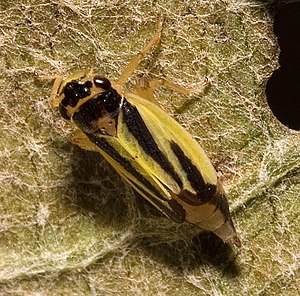Meadow hoppers
| Meadow hoppers | ||||||||||||
|---|---|---|---|---|---|---|---|---|---|---|---|---|

Meadow leaf hoppers ( Evacanthus interruptus ) |
||||||||||||
| Systematics | ||||||||||||
|
||||||||||||
| Scientific name | ||||||||||||
| Evacanthus interruptus | ||||||||||||
| ( Linnaeus , 1758) |
The meadow cicada ( Evacanthus interruptus ) is a round head cicada from the family of dwarf cicadas (Cicadellidae) within the order of the Schnabelkerfe (Hemiptera). The insects are variable yellow-black, although the dark drawing is sometimes completely missing. They are often very numerous and noticeable in wet meadows .
distribution and habitat
The meadow plant cicada has a Palearctic distribution, it occurs from Europe to Siberia, in the south to North Africa. It mainly inhabits moist and nutrient-rich meadows ( cabbage thistle meadows ), but also mountain meadows in the Alps up to an altitude of over 2000 m. It can also be found in alder quarries and occasionally on limestone slopes.
features
The insects are colored gold to orange gold, with variable dark markings that are sometimes completely absent. The dark markings often appear in the form of dark longitudinal bands on the forewings, which continue on the abdomen in short-winged forms. Some of the animals are more or less shiny. They reach body lengths between 5 and 7 millimeters, with the females becoming significantly larger than the males. They are long-winged (macropter), partly also short-winged (brachypter); the abdomen is only partially covered by the forewings. The antennae are short and consist of two strong base members and a thin flagellum.
Way of life
The animals feed on plant juices, which they ingest with their specially built, piercing-sucking mouthparts . They are polyphagous, which means that they use a variety of different, but predominantly tall, plant species as food. They use the xylem sap that rises in the plant, preferably from sunflower (Asteraceae), such as water dost ( Eupatorium ), thistle ( Cirsium ), butterbur ( Petasites ) or ragweeds ( Senecio ). Furthermore, they intersucking nettle ( Urtica ), deadnettle ( Lamium ) and willowherb ( Epilobium ).
The meadow leaf hoppers are hemimetabolic , the larvae develop directly. They and the adult animals basically have the same body structure. With increasing age, the systems for the wings and genital fittings grow and grow. The animals go through five larval stages. In Central Europe they form one generation a year ( univoltin ) and overwinter in the ice stage. Adult animals appear in Central Europe from mid-June, they can be found around mid-October.
literature
The information comes from the following literature:
- R. Biedermann & R. Niedringhaus: The cicadas of Germany - identification tables for all species. Fründ, Scheeßel 2004, ISBN 3-00-012806-9 .
- R. Remane & E. Wachmann: Cicadas - get to know, observe. Naturbuch Verlag, Augsburg 1993, ISBN 3-89440-044-7 .
- H. Nickel: The leafhoppers and planthoppers of Germany (Hemiptera, Auchenorrhyncha): Patterns and strategies in a highly diverse group of phytophagous insects. Pensoft, Sofia and Moscow 2003, ISBN 954-642-169-3 .
Web links
- Evacanthus interruptus in Fauna Europaea